
LIGHT UP –
The Potential of Light in Museum Architecture


The Potential of Light in Museum Architecture
Whether one beholds the space where art is displayed or the art being displayed within, light is the common denominator.
The interrelationship between the arts, as well as two different perspectives regarding the use of light as a material in the exhibition space, forms the springboard for Light Up – The Potential of Light in Museum Architecture As an architect, I examine the subject through an analytical approach to exhibition space and museum architecture. My perspective has been broadened by the insights of Friedrich Biedermann, an artist who uses light as a medium in his works.
Both of us studied at the University of Applied Arts Vienna and over the course of our long careers as architect and artist we have pursued this theme. Together, we developed a theory of the objectoriented ontology of light , which regards light as spiritual matter uniting the architectural space, the artwork and the viewer. Once one sees light as a material in the museum, then one can begin to assess its potential in the exhibition space. In galleries and art museums, our perception of art, space and atmosphere is essentially determined by lighting. This book begins by asking why lighting is simply taken for granted, regarded merely as a light source rather than as a creator of mood affecting our perception of an artwork, allowing us to view and interpret it in new ways.
Western society spends more than 80 percent of its time indoors in private and public spaces—mostly artificially illuminated. What is the character of these artificially lit spaces and how do we experience them? When measured with a digital spectrometer, the quality of illumination in a prestigious museum is hardly different to the light spectrum found inside a typical fast-food restaurant. Commercial businesses purposefully use lighting to manipulate specific consumer behavior. Can the same be said in the context of exhibition architecture? Our measurements of the lighting conditions in actual exhibition spaces have revealed remarkable disparities in light quality, raising questions about how art can convey different meaning under different lighting conditions.
The evolution of light sources and their relative lighting qualities over the past decades has shaped our perception of art. Perhaps it has impacted art itself. Could the popularity of acrylic paints in contemporary art be the result of the prevalent use of fluorescent lighting in exhibition spaces and artist studios during the 1980s? Today, pioneering LED technologies allow us to create customized lighting scenarios. Artificial light is becoming an interactive material in museum architecture, not only in terms of conceptual design but as real-time spatial experiences. Exploring the potential of dynamic artificial lighting technologies in museum architecture opens up new perspectives and approaches to the use of light in exhibition spaces. But how should art experts, museum professionals and exhibition designers decide upon which light settings to use?
One must understand darkness in order to work with light. Otherwise how can one isolate light and regard it separately from interpretation? How is one supposed to find the balance between awareness and interpretation? In the past we perceived natural light filtered through church windows, while today we behold the artificial light of our smartphones. From day one, we are exposed to and interpret light, which we take for granted and enjoy! Therefore, it is not so easy to differentiate light from perception! My approach begins with dark spaces. For me, light is an ongoing experiment that conveys evidence and existence, and it changes from day to day. Our primal instincts are imprinted within us. Wary of darkness, we turn to the light. Certain colors in nature signal danger. Light can have a calming or a compelling effect on us. All this information is stored in our DNA.

One should be able to change the heights and the widths of the rooms at will. If possible, automatically. Skylight, daylight from side, should be excluded. All in all, an ideal museum would be changeable to any size, and dimension, and the light, too.
Dynamic artificial lighting offers artists, architects, curators and museum experts nearly unlimited possibilities for illuminating an exhibition space. But how should the various nuances of artificial light interact with the artwork and the exhibition space? What potential does dynamic artificial lighting provide as an interactive material in galleries and art museums? What is the relationship between light and the artwork, exhibition space and audience? What happens to this relationship when lighting is implemented as an interactive tool? Can dynamic artificial lighting design be controlled within the exhibition space? What are the signature characteristics of contemporary lighting?
Digital measurement methods can be integrated with digital light sources making it possible to transfer lighting moods dynamically from one space to another. Just as it is possible to digitally scan an object, a room or a building and then plot it as a three-dimensional model, it is also possible to measure the light at a specific location using a digital spectrometer, store the data and reproduce it in a new environment using state-of-the-art lighting technology. It is thus theoretically possible to reproduce in the exhibition space the light under which a work of art was created in the studio. One could also reproduce the light used at New York City’s Museum of Modern Art (MoMA) in Vienna’s Museum of Modern and Contemporary Art (mumok). Taking this concept further, one might use digitally controlled dynamic lighting systems to travel in time—for example, from the light of the present day to that of the Baroque—or to transport the light of Central Europe to the light of the North or South. How might such possibilities impact museum lighting in the near future?
When one recognizes that light determines and shapes the appearance and perception of art and its exhibition spaces, one can see the potential of dynamic artificial lighting within galleries and art museums as an interactive material for artists, architects and curators. This was analyzed from an architect’s standpoint—one that regards light as an environmental material—specifically, by evaluating whether dynamic artificial light sources can perfectly reproduce natural lighting conditions.
Light is a variable that allows us to interact with the space, the art and the audience in real time. Therefore, with regard to contemporary art, our goal as exhibition designers should be to create a contemporary exhibition space. This goal is based on the realization that our perception of art has always been shaped by prevailing artificial-lighting technology. Artificial light has become more relevant as museums have shunned natural light (for conservation reasons) and the white, neutralizing space has become the standard credo of exhibition architecture, whose main goal has been suppressing any distraction from the art itself. Because of this, over the past decades, our perception of art has depended upon the quality of the light sources applied in each case. It can be argued that lighting within the exhibition space has the potential to influence artistic developments: Might acrylic paint have gained prevalence because of fluorescent lighting? Dynamic artificial lighting could become an incubator allowing new art to develop, generating new freedoms in the creative process and the choice of materials. Light can now be dynamically harmonized with the art.
Dynamic lighting allows us to perceive art in all its facets. Our perception of an artwork can be altered by its illumination. Such changes can be induced deliberately and used as a design tool. In the process, the question of light’s potential is directly related to the issue of the light of our day. Indeed, dynamic artificial lighting enables us to actively influence the established pattern of relationships in the here and now.
The findings of the White Cube Teleporter research project demonstrate that a dynamic artificial light source can disrupt the predominant patterns of relationships between exhibition space, art and the viewing public, thereby opening up new levels of perception. It has been shown that viewers’ preferences for how art is illuminated vary considerably and do not directly correspond with the prevailing lighting we currently encounter in museums. In the first case study, we could ascertain that the audience preferred light with cool color temperatures for viewing early 20th-century portraits, and light with warm color temperatures for abstract contemporary art—a result at odds with the light settings prevalent in today’s museums. Surveys of existing museums have shown us that we currently experience art under static light sources with a constant color temperature that varies depending on the illuminants used, and that contemporary art is primarily displayed under cool color temperatures, unlike historical paintings, which are typically viewed under a color temperature of around 2,700 Kelvin. As a dynamic changing light source, the sun plays an essential role in the development of our visual perception of objects and space, color and three-dimensionality. Accordingly, dynamic and changing light should be a basic need for viewing art.
Results from the White Cube Teleporter series of experiments indicate that light supports the dialogue between viewer and art and can be used deliberately as a filter. Light acts as a mediator between definition and diffusion. In this way, light delineated the contours of the portraits and defined the facial features more strongly. It altered the portrait subjects’ facial complexion, thus altering how we associate their character traits. We could use light to change the perception of depth in abstract images, shifting the relationship between foreground and background. Dynamically changing the light settings brought out different details of image content and the pictures became animated. The lighting gave the process of viewing art an unexpected dynamism. Even though we were able to discover all these aspects in the course of our series of experiments, we were unable to provide empirical evidence that light can significantly influence our appreciation of art. Even though we have not yet succeeded in establishing evidence for this, I believe that light can actively change our perception of art.
Experience has shown that users of dynamic lighting systems are often overwhelmed by the manifold options available to them. Our expertise allows us to select customized presets for them. When it comes to the targeted implementation of dynamic artificial light sources, it is up to us to actively design lighting settings and lighting programs that ease the users’ decision-making by limiting the available options. Therefore, for our above-mentioned testing, the selection was limited to five settings. Public viewers were given the ability to change these settings at will. The choice of program and especially the speed with which the selection was made, as well as the duration of each setting, varied greatly and obviously depended largely on each individual’s personality. The diverse participants included both quick studies, who ran through the programmed lighting settings in rapid succession, and leisurely indulgers spending several minutes with each respective setting.

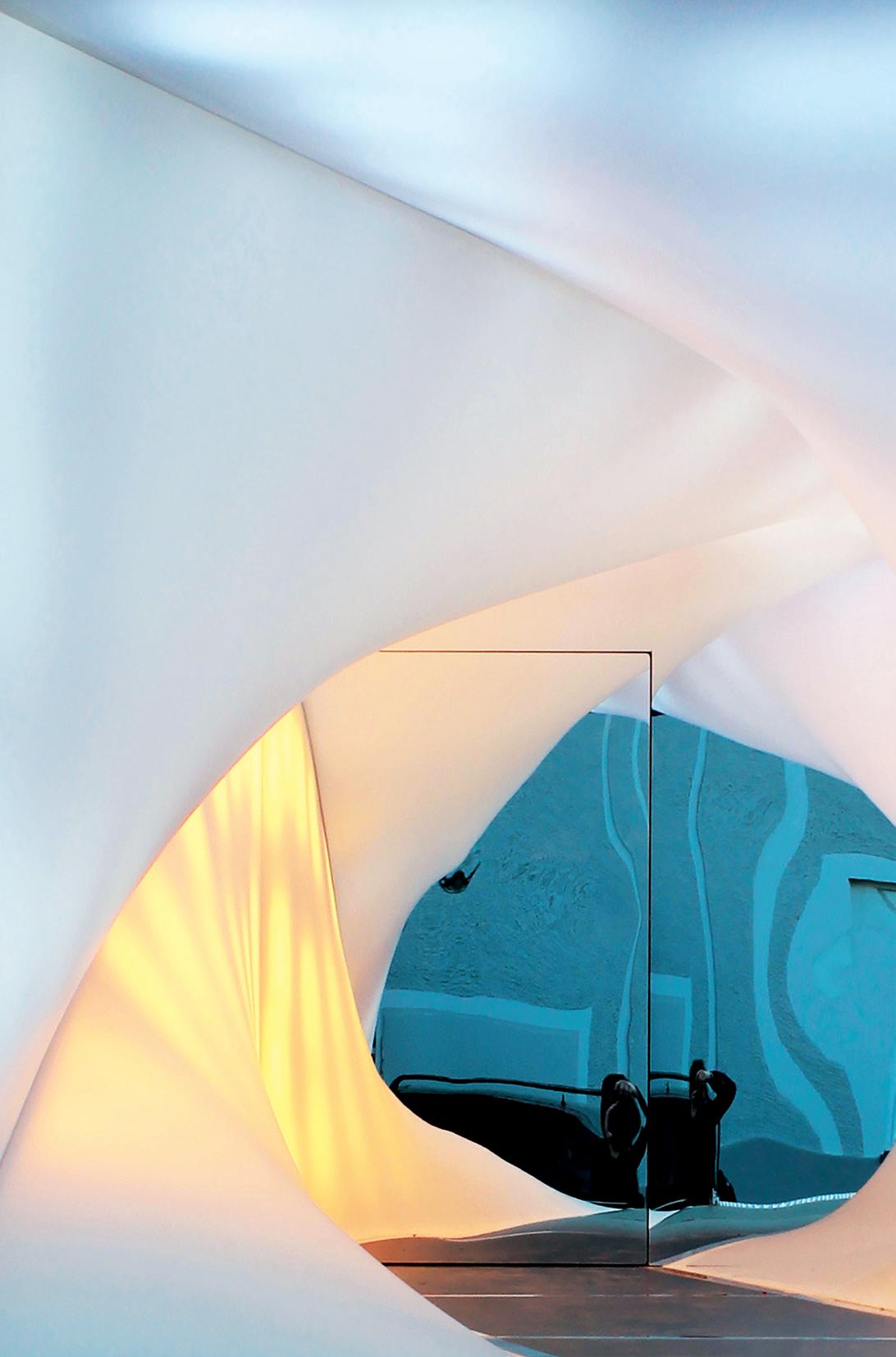
Our understandings of light are thus entwined with our conceptions of space. They have coevolved: moral space and spiritual light, perspective space and geometrical light, material space and substantial light. Each age emphasized one face of light and so revealed its own predilections.
(Zajonc 1993: 99)
Light is a fascinating subject. If one speaks of light as a material, one simply cannot explain its nature using only mathematical and physical laws. Scientific insights and discoveries form the basis for approaching the topic and then for working out the specifics for how dynamic artificial lighting can qualitatively simulate natural light. However, the question of the essence of light remains. This insight has become increasingly important to me, especially in the course of conducting our White Cube experiments.
When we enter a museum, we become immersed in a certain ambience that establishes our perception of the surroundings and the architectural environment.
In the context of Gothic church interiors, such ambiance is generated almost exclusively by light, such as in Abbot Suger’s reconstruction of the Basilica of Saint-Denis, located north of Paris. The beauty of this context is that light can reveal its true nature before it undergoes manipulation or modification. That is to say, the light itself—its natural color, its changing intensity and the dynamic flow of daylight—is used as a design tool to create the space’s atmosphere. This is basically how artificial lighting is defined within the contemporary field of Human Centric Lighting: pure white light, whose changing color temperature and intensity are modeled on natural sunlight, mimicking its spectrum and attempting to reproduce daylight in all its nuances.
While the Gothic period architecture appreciated light for its purity, Baroque architecture casts it in an interplay of form, color and material—a role that we now associate with the term “effect lighting.” Baroque light no longer appears exclusively in its natural purity, but is applied in combination with filters and reflectors, such as colorful stained-glass windows that transform the pervasive daylight. Three-dimensional forms create spatial shadow plays and the color gold takes on high importance. The so-called “Golden Hour” in Vienna’s Jesuitenkirche affords a very impressive example of this. During the summer months, the sinking rays of the setting sun bathe Andrea Pozzo’s 1702 baroque church interior in sublime evening light, illuminating the heavily gilt space in all its glory. As the sun sets, its rays slowly traverse the interior, allowing us to experience the space dynamically, almost as though one were witnessing a three-dimensional computer animation. The three-dimensional, moving imagery shapes our spatial experience.
Today, our relationship to light has changed significantly. Never before has lighting been more integrated into our lives. We are constantly immersed in it. We spend hours in front of our computer screens or smartphones. Virtual imagery shapes our perception of light, color and space in a way that has never been experienced before. As our visual perception is based on the processing of experiences, our understanding of light changes daily. For example, it is interesting to observe how colors in movies and animation disappear as the imagery in these media has become paler and more monochromatic. Do we long for a certain purism within the flood of visual imagery? Might our responsibility in handling dynamic light sources be counteracting visual overstimulation? Is this the zeitgeist of the light of our day?
[Each space] has its own character that impinges on us and takes hold of our feelings so that it falls into accord with this mood.
When you enter an art museum, it is one of those moments when you feel as if the pause button has been pressed and the experience of the space and discovery of the artworks are solely yours. Although museums are public buildings, usually well attended, this magic prevails and, I suggest, it is the atmosphere of the building and exhibition space that surrounds and captivates us. It creates a space that engages us and makes us recognize that we are in a unique place. Typically, one takes one’s time to visit a museum and opens oneself up to the art. Consciously or not, we allow the site, the space and the architecture to affect us. According to Bollnow (cf. Bollnow 1963: 229ff.), each space has its own mood and he ascribes this to the atmospheric conditions.
Primarily concerned with visible space, Bollnow’s categorization of day and night space could be compared to the findings of research into light’s impact on the day-night cycle, the so-called circadian rhythm, which essentially shows that our perception of day and night also takes place on a nonvisual level. Several recent studies address the impact of artificial light on our biorhythms, wellbeing and behavior (cf. Chew et al. 2016; Hertog et al. 2015; Llenas and Carreras 2019; Llenas et al. 2019). Behavioral studies in workplaces, schools and clinics reveal the connections between dynamic lighting controls and mood, well-being, visual comfort and daynight rhythms. In the museum, not only the perfect illumination of art, but also the experience of art plays a major role. We feel emotions when we view art. If we recognize that light also influences our well-being, then we can conclude that the lighting of art also influences our emotions. So, one should focus on new technical achievements and scientific findings in lighting research (cf. Hurlbert et al. 2020). After all, the experience of art plays a key role in its interpretation.
In the context of lighting, “dynamic” describes lighting that varies over a given period of time as a result of regulating one or more of its parameters—for example, its intensity, luminous color or direction. While special dynamic lighting technologies can render all colors in the RGB spectrum, my investigations focused exclusively on light sources that can simulate dynamic white light and daylight. This is what the lighting industry likes to refer to as Human Centric Lighting (HCL), a term that does not describe a specific lighting technology but rather light sources whose color temperatures and intensity can be dynamically adjusted to emulate sequences of daylight.
Deployment of dynamic light sources requires the use of an intelligent lighting-control system such as Casambi (Bluetooth). Two different control systems were used in our experiment setup: DMX and ZigBee. DMX (Digital MultipleX) is a wired system using the Loxone Smart-Home software to program the lighting, while ZigBee is operated via a wireless network and uses myPi-LED software provided by the manufacturer. Both systems allowed us to preset the light sources numerically (color temperature / XY coordinates) and via controllers (lux) and to activate them according to light values recorded at mumok (Vienna’s Museum of Modern and Contemporary Art). The myPi-LED software allowed us to program and reproduce different dynamic sequences, as well.
So, when we talk about dynamic light sources, it means that their intensity and color temperature can be changed. If the course of the sun (3,200 K at dawn to 5,500 K at high noon) is depicted in the color triangle, it lies exactly on Planck’s curve (see fig. 9, below).

The illuminant PiLED used for our experiment setup is capable of simulating dynamic white light that exactly follows Planck’s curve, unlike the x-y values of many common light sources that emit white light. Take, for example, the lighting measured in Vienna’s subway cars. Here, the values of the illuminants lie above Plank’s curve on the x-y axes (see fig. 10, below). If the deviation is too large, the light no longer appears to be pure white.
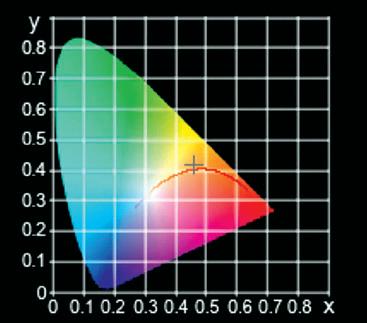
As designers, we bring the sun into the space in the form of dynamic artificial lighting and can deploy it flexibly. But what are the properties of white light and how can these properties be used in design?
The color shades of visible white light (along Planck’s curve) can be ascribed to various color temperatures [Kelvin (K)]. We describe light in this context as cold or warm. The following classification can be found in the European standard (EN 12464-1:2021):
LIGHT COLOR CORRELATED COLOR TEMPERATURE (in K)
Warm white ≤ 3,300
Cool white 3,300–5,300
Daylight white ≥ 5,300
For example, the spectrometer gives me readings in the range of 1,500 K to 2,100 K for candlelight, depending on the particular candle tested. These values lie on the far right of Planck’s curve in the color triangle. The Kelvin values of daylight range from ~2,000 K to ~20,000 K, depending on the time of day and cloud cover and whether one is measuring direct sunlight or diffuse sky radiation. There are no standards for how to plan the application of light color. Over the past decades, designers deploying artificial lighting have been dependent on light sources that (compared with daylight) only render a specific static color temperature within a range (see table 5).
This is now different with LEDs. We now have at our disposal a wide range of color temperatures by deploying both fixed white LEDs and color-changeable LEDs. It is now possible with LEDs to bathe art in the color temperature of, for example, candlelight or daylight.
Color temperature describes only the luminous color of an illuminant but does not provide any information about the mixture ratio of the spectral colors. Two illuminants can have identical color temperatures, although their spectra differ significantly. If you analyze the spectrum for each respective illuminant, striking differences in quality become apparent. Compared to sunlight, which is characterized by its full spectrum, fluorescent lighting, for example, has an incomplete spectrum; some color components are missing. This can be seen clearly when looking through a handheld spectroscope (see fig. 11).
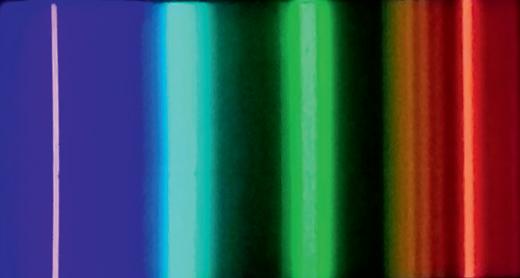
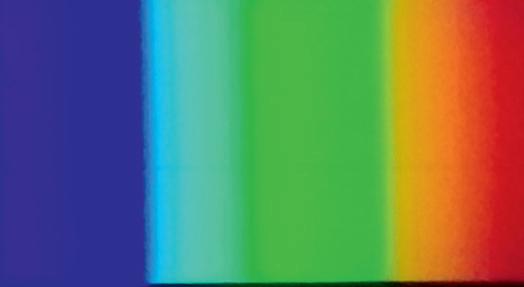


Two-channel (warm white and cool white) or three-channel (RGB) systems are typically used to produce dynamic white light. There are systems with five or more channels, as well.
The two-channel system is known as “Tunable White.” It enables dynamic white-light gradients ranging from 2,500 K to 6,500 K. Because the Tunable White system consists of two channels, it is only possible to generate a gradient between the different color temperatures. If one tries to reproduce a range larger than 2,500 K to 6,500 K with this method, its middle range deviates from Planck’s curve too much, which directly impacts the quality of white light.
Since 2014, I have been interested in a lighting technology patented in 2008. It emerged as a visionary technology in 2018, due to its control system. Companies such as Osram and Philips have entered into licensing agreements to build such controls into their Tunable White systems. Unlike commercially available RGB systems, the three-channel PiLED replaces the green light-emitting diode with a mint-colored one, augmenting the standard red and blue LEDs. This makes it possible to generate comparatively higher-quality white light. This method of color mixing, developed by the physicist Hans Hoschopf, enables a continuously variable rendering of white light exactly along Planck’s curve, thus yielding considerably more color temperatures that can be rendered with Tunable White (see fig. 16, above). The PiLED can dynamically render all color temperatures in the range from 1,800 K to 16,000 K (CRI > 90) along the curve.
During the measurement process, the spectrometer’s user interface allowed me to select which data were displayed from among four optional screen displays (BASIC/SPECTRUM/CIE1931/ CIE1976), and it was possible to change views while measuring. I chose the spectrum setting to begin with. It was fascinating to note the vastly different spectra between the various museums; even when there was some commonality—in color temperature and illuminance, for example—the spectral imaging usually appeared quite different. My main focus with the first measurements was therefore exclusively on the spectral images. Figure 19 shows selected results—the striking differences can be seen clearly. The measurement results recorded in these spectral analyses were used for Case Study 03, during which the test subjects could see a display of light-measurement data for each respective space.

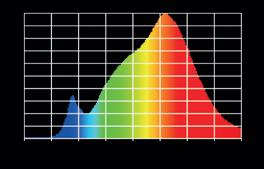
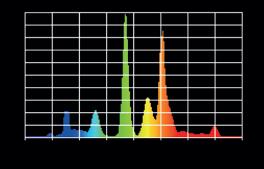
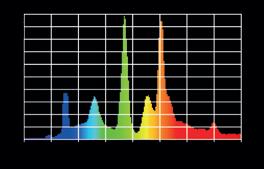





While conducting these light surveys in the museums listed above, I kept notes on my observations. Here are a few unedited excerpts that give some insight into the process of surveying the buildings and rooms.
The significant difference between the lighting conditions in the circulation areas and those inside the exhibition spaces was striking. When you enter mumok, daylight follows you into the 35-meter-high (115-feet-high) foyer, flooding the lofty space from above. Bridges connecting different exhibition levels are reached via centrally located glass elevators.
Light measurements began in the large gallery on the top floor— the only exhibition space in the museum where daylight comes into play. It enters the room through a large opening in the arched ceiling and through panoramic windows. All other galleries are artificially illuminated. Therefore, except for the top floor survey, the measurements exclusively represent the qualities of artificial lighting. The rooms were measured in sequence, from the top to the bottom floors. The measurements took place under the supervision of a museum security officer.
The lighting conditions in the exhibition spaces stood in contrast with the daylight in the circulation areas between them. I found the repeated shifting contrast between daylight and artificial light to be quite a strain on the eyes. The lighting conditions in the various exhibition spaces were nearly identical. Most of the lighting came from recessed ceiling fixtures, with one exception: the small gallery on level 2 was already outfitted with LED spots.


While in our previous experimental setups we programmed the light settings with the static values measured at the individual referenced museums, we now deployed variable light settings. By doing so, the range of variation between the highest and the lowest values measured at each respective museum was now emulated by the gallery’s dynamic lighting. This made it clear that whenever we attend an actual exhibition, we are exposed to a variety of static lighting scenarios. At this point, I could now understand that lighting cannot be represented as an immutable museum standard. While the lighting ranged between 2,900 K and 3,500 K at the Museum of Applied Arts (MAK), it underwent a broader, more dynamic range between 4,040 K and 7,000 K at the Belvedere 21 setting (see table 14), because the latter’s windows permit daylight to enter sideways.
<Scene remark=„KHM - 2900K“>
<Setting cct=„2700“ brightness=„178“ endpoint=„11“ />
<Setting cct=„2700“ brightness=„178“ endpoint=„12“ />
<Setting cct=„2700“ brightness=„178“ endpoint=„14“ />
</Scene>
<Scene remark=„MAK - 2900K / 3500K“>
<Setting cct=„2900“ brightness=„255“ endpoint=„11“ />
<Setting cct=„3300“ brightness=„255“ endpoint=„12“ />
<Setting cct=„3500“ brightness=„255“ endpoint=„14“ />
</Scene>
<Scene remark=„MQ - 2900K / 3700K“>
<Setting cct=„3700“ endpoint=„11“ />
<Setting cct=„2900“ endpoint=„12“ />
<Setting cct=„3300“ endpoint=„14“ /> </Scene>
<Scene remark=„Belvedere21 - 2950K / 7000K“> <Setting cct=„4400“ endpoint=„11“ /> <Setting cct=„2950“ endpoint=„12“ /> <Setting cct=„7000“ endpoint=„14“ /> </Scene>
<Scene remark=„Secession - 4500K / 10000K“>
<Setting cct=„5000“ endpoint=„11“ /> <Setting cct=„4500“ endpoint=„12“ /> <Setting cct=„10000“ endpoint=„14“ /> </Scene>
<Scene remark=„Lentos - 2900K / 9400K“> <Setting cct=„2900“ endpoint=„11“ /> <Setting cct=„4090“ endpoint=„12“ /> <Setting cct=„9400“ endpoint=„14“ /> </Scene>
<Scene remark=„Kunstforum - 2900K / 3500K“>
<Setting cct=„3000“ brightness=„100“ endpoint=„11“ /> <Setting cct=„2900“ brightness=„100“ endpoint=„12“ />
<Setting cct=„3500“ brightness=„100“ endpoint=„14“ /> </Scene>
<Scene remark=„Leopold - 2900K / 4000K“>
<Setting cct=„4000“ endpoint=„11“ />
<Setting cct=„2900“ endpoint=„12“ /> <Setting cct=„9700“ endpoint=„14“ /> </Scene>
<Scene remark=„Rainermuseum - 2500K / 10000K“>
<Setting cct=„5000“ brightness=„255“ endpoint=„11“ />
<Setting cct=„2500“ brightness=„255“ endpoint=„12“ />
<Setting cct=„10000“ brightness=„255“ endpoint=„14“ /> </Scene>
<Scene remark=„Belvedere - 2900K / 5600K“>
<Setting cct=„2900“ endpoint=„11“ /> <Setting cct=„3550“ endpoint=„12“ /> <Setting cct=„5600“ endpoint=„14“ /> </Scene>
<Scene remark=„Ferdinandeum - 2950K / 5300K“>
<Setting cct=„3300“ endpoint=„11“ />
<Setting cct=„2950“ endpoint=„12“ />
<Setting cct=„5300“ endpoint=„14“ /> </Scene>
<Scene remark=„KunsthalleMQ - 2750K / 3300K“>
<Setting cct=„3000“ endpoint=„11“ />
<Setting cct=„2750“ endpoint=„12“ />
<Setting cct=„3300“ endpoint=„14“ /> </Scene>
<Scene remark=„Albertina - 3000K / 4000K“>
<Setting cct=„3000“ endpoint=„11“ />
<Setting cct=„3500“ endpoint=„12“ />
<Setting cct=„4000“ endpoint=„14“ /> </Scene>
Studio Okular, A-Vienna, www.studio-okular.com
Printed with the financial support of the University of Applied Arts Vienna
Project Management “Edition Angewandte” on behalf of the University of Applied Arts Vienna: Anja Seipenbusch-Hufschmied, A-Vienna
Content and Production Editor on behalf of the Publisher: Katharina Holas, A-Vienna
Translation from German into English and proofreading: Michael Bernstein, A-Vienna
Layout, cover design, typography, and image editing: Caroline Ecker, ce-design, A-Vienna / Wald a. A.
Printing: Holzhausen, the book-printing brand of Gerin Druck GmbH, A-Wolkersdorf
Paper: Sappi Raw 135 g/m2, Koehler Eco Black 270 g/m2
Typeface: Avenir, Baskerville, Circe Slab A
Images: © the authors (unless otherwise indicated)
Considerable effort has been made to trace copyright holders of images. The author and publishers apologize for any errors and omissions, and, if notified, will endeavor to correct these at the earliest opportunity.
Library of Congress Control Number: 2022947757
Bibliographic information published by the German National Library
The German National Library lists this publication in the Deutsche Nationalbibliografie; detailed bibliographic data are available on the Internet at http://dnb.dnb.de.
This work is subject to copyright. All rights are reserved, whether the whole or part of the material is concerned, specifically the rights of translation, reprinting, re-use of illustrations, recitation, broadcasting, reproduction on microfilms or in other ways, and storage in databases. For any kind of use, permission of the copyright owner must be obtained.
ISSN 1866-248X
ISBN 978-3-0356-2705-3
e-ISBN (PDF) 978-3-0356-2706-0
© 2023 Birkhäuser Verlag GmbH, Basel
P.O. Box 44, 4009 Basel, Switzerland
Part of Walter de Gruyter GmbH, Berlin/Boston